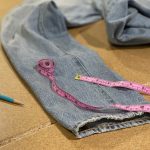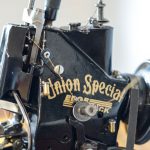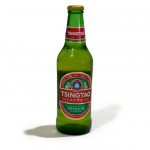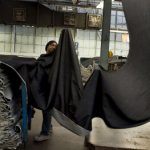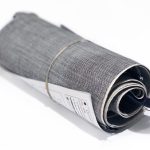TCB Jeans crafts history into every stitch, reviving iconic denim like the 1966 Levi’s 501 and the 1955 Levi’s 701 with unparalleled authenticity. It's not just about wearing jeans; it's about embodying a piece of denim's storied past, meticulously re-created...
Read More →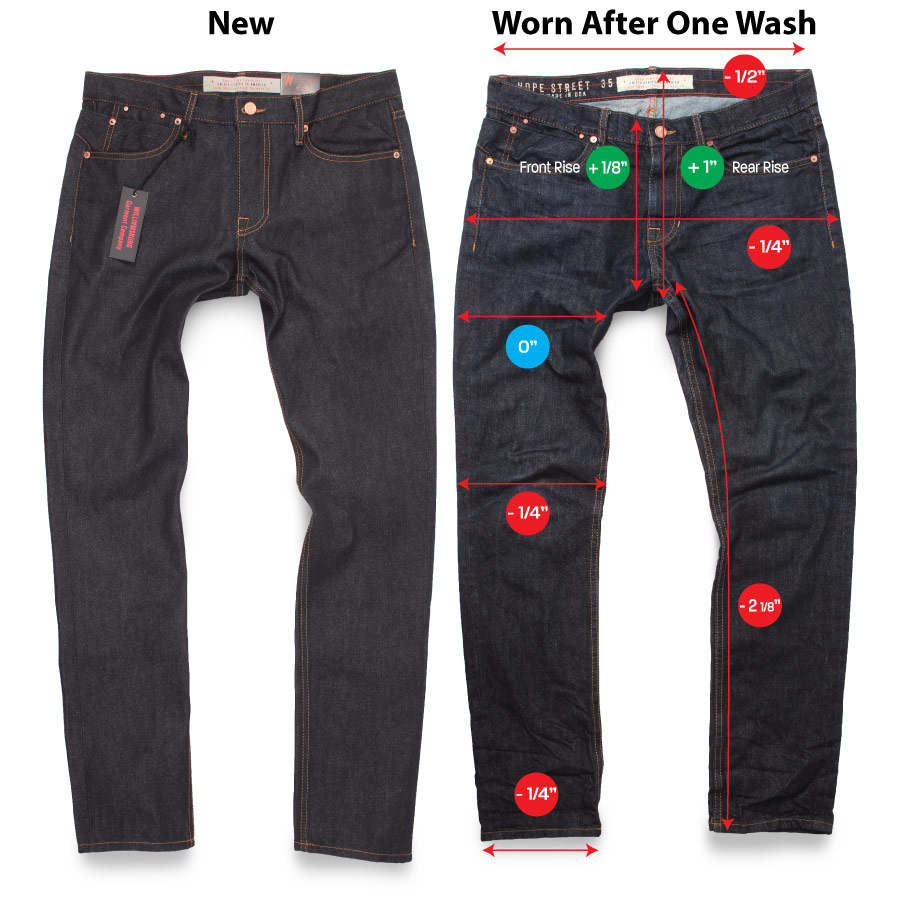
Hope Street questions answered: How much does raw denim shrink and stretch?
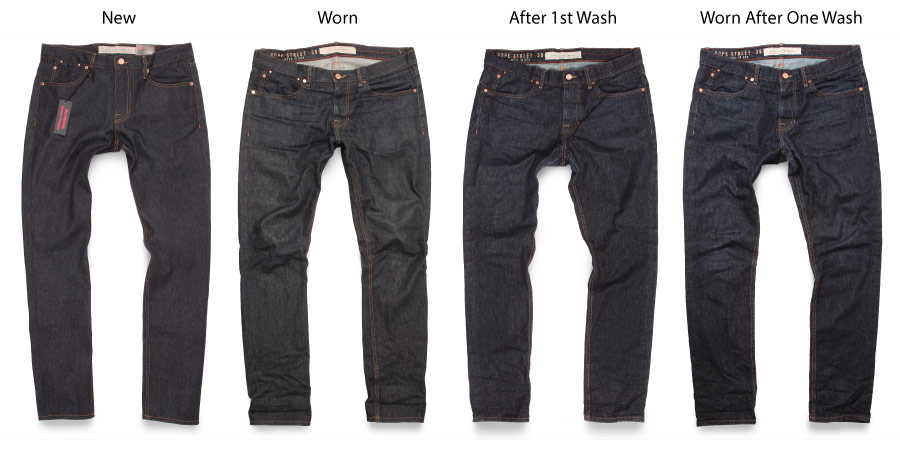
Starting with a fresh new pair of men’s raw denim Hope Street jeans, I recorded measurements of my size 35 jeans. The jeans were worn on average about two days per week for about a year.
One thing I noticed about my Hope Street jeans is they remained very dark even after a year plus of wearing causally and beating them up pretty well in the warehouse. I asked Blake, my sales rep from Cone Denim about this and he told me the denim used in the Hope Street jeans was their darkest pure indigo shade. He went on to say, “it’s 40% pure. That shade is engineered to give the best possible range of shade.” This means that once you do manage to wear the denim down, the multitude of aging tones in the indigo will be beautiful.
Working from the Williamsburg denim store every day, I found myself educating people on things like, “what are selvedge jeans?” Washed vs. raw jeans and how much does raw denim shrink and stretch. The expansion experienced while wearing raw denim jeans and the shrinkage that occurs after washing has been the most challenging conversations. To aid and give visuals to the discussion, I made it my goal to personally begin testing every style of Williamsburg jeans for denim shrinkage and growth. Starting with measurements taken from jeans while new and raw, to the point where they grow after months of wear and ending with recording after-wash measurements, followed by after-wash/after-wear measurements.

Below, are the measurements from Hope Street, non-stretch, standard raw denim jeans before wear. Followed by the measurements of the jeans after washing and then wearing them for 2 days – stretching and growing the jeans to a size that ends up being slightly smaller jeans than they were in the beginning.
New: Size 35
Waist Band: 39”
Seat: 43 ¾”
Front Rise: 10 ¾”
Rear Rise: 15”
Thigh: 26”
Knee: 17 ¼”
Hem: 14 ½”
Inseam: 35
Washed & Worn: Size 35
Waist Band: 38 ½”
Seat: 43 ½”
Front Rise: 10 ½”
Rear Rise: 16”
Thigh: 26”
Knee: 17”
Hem: 14 ¼”
Inseam: 32 7/8”
In high-stress areas like the waistband, seat, and knees, the denim shrunk a good amount after the first wash. However, after a short time of wear, the fabric expanded relatively with ease. At the rise and thigh, the areas that stretch the most, the changes canceled each other out, growing a great deal while raw, then shrinking and enlarging again shortly after wash and wear. The inseam which sees very little growth during the break-in process is only really affected by shrinkage and loses about 2 inches.
You might be interested in
TCB Jeans crafts history into every stitch, reviving iconic denim like the 1966 Levi’s 501 and the 1955 Levi’s 701
Nick English from Stridewise visited our studio at 67 West Street to expertly tailor his jeans at the waist. Watch
In a sea of seasonal brews, Master of Pumpkins Ale by Tröegs Independent Brewing rises to the top. Our review
How to measure the inseam of twisted-leg jeans is made clear in our video lesson. Learn how to handle this
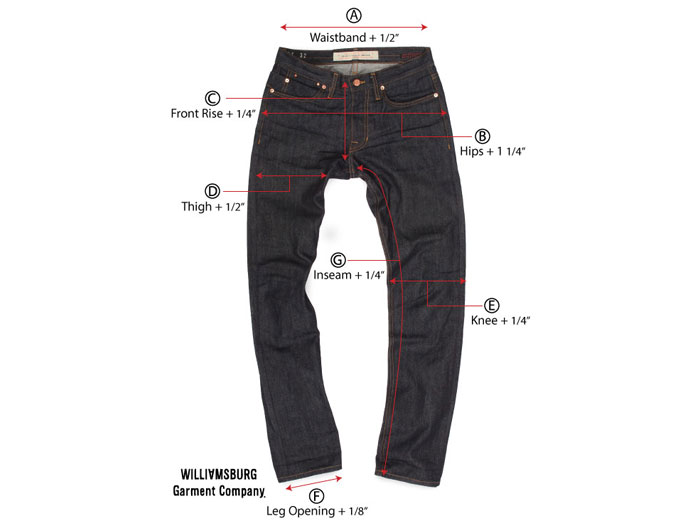
We decided to create this quick guide to answer a common question about breaking in raw denim jeans. One of the most common questions for those looking to buy a pair of raw jeans for the first time is “ How much does raw denim stretch?”
We took measurements from a customer’s jeans after he had worn them for about 2 months and then compared them to the original measurements of the jeans. Here is what we found.
- A. The waistband grew 1/2″ (total circumference)
- B. The hips grew 1 1/4″ (total circumference)
- C. The front rise grew 1/4″
- D. The thigh grew 1/2″ (total circumference)
- E. The knee grew 1/4″ (total circumference)
- F. The leg opening grew 1/8″ (total circumference)
- G. The inseam grew 1/4″
To answer wash and shrinkage questions, earlier experiments of the raw denim jeans in these styles show the shrink rate at 3.5% in width and 2.5% in length.
You might be interested in
TCB Jeans crafts history into every stitch, reviving iconic denim like the 1966 Levi’s 501 and the 1955 Levi’s 701
Nick English from Stridewise visited our studio at 67 West Street to expertly tailor his jeans at the waist. Watch
In a sea of seasonal brews, Master of Pumpkins Ale by Tröegs Independent Brewing rises to the top. Our review
How to measure the inseam of twisted-leg jeans is made clear in our video lesson. Learn how to handle this
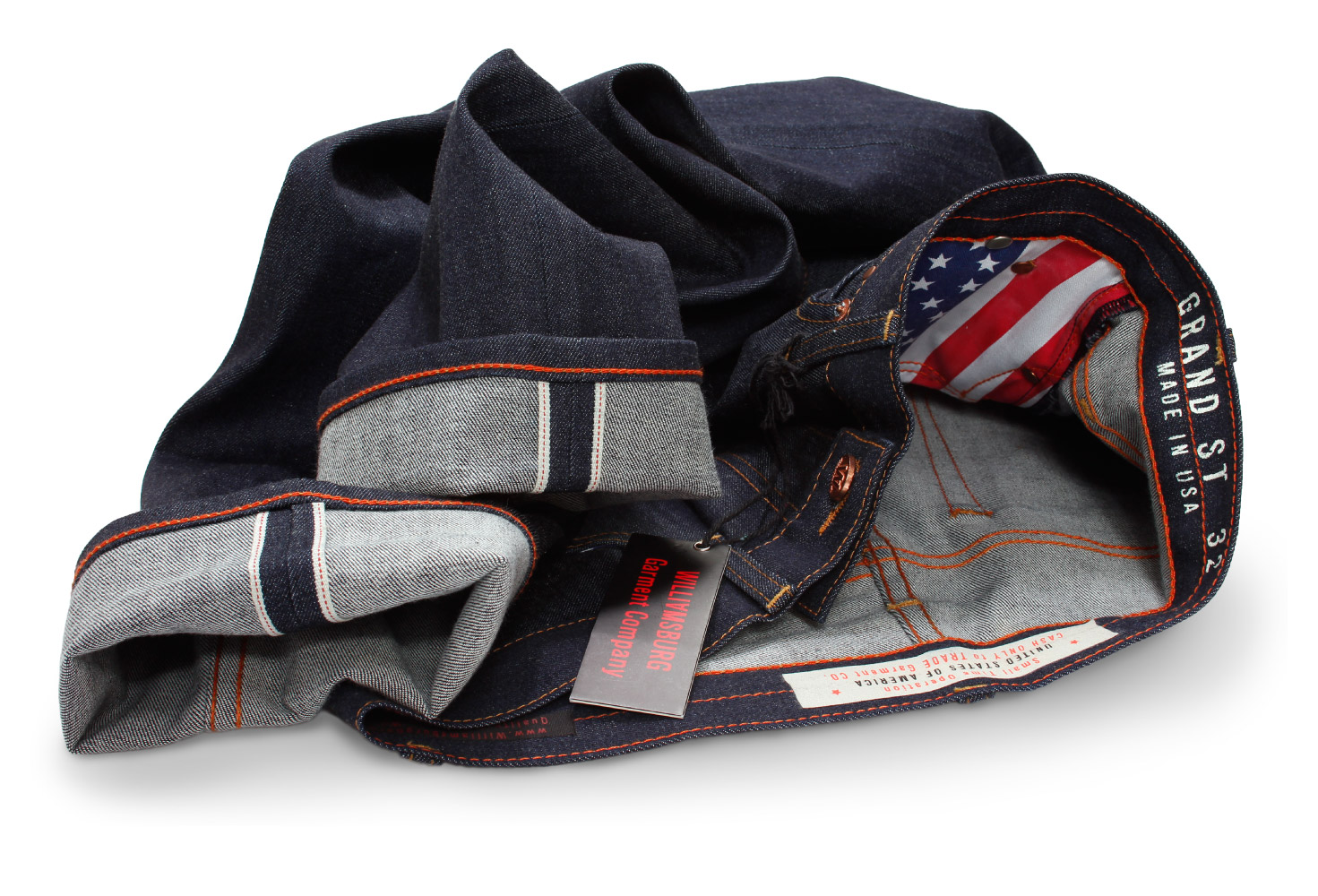
Angry voters addicted to cheaper products have finally woken up and realized free-trade and trickle-down policies haven’t really worked out well for them.

In this super-heated political season, the one good thing politicians are finally talking about is bad U.S. trade policies (we accept goods from some countries with less restrains than they give us to export to them). Many angry voters addicted to cheaper products have finally woken up and realized Free Trade and Trickle Down policies haven’t worked out well for them. It feels like there are now more closed factories than good-paying factory jobs and both Democrats and Republican voters are angry with their Party Establishment whose main interest seems to be supporting Big Businesses and Contributors to their campaigns, which has aided in eroding the U.S. manufacturing base in exchange from greater profits for investors. Over the past few decades, the rich have gotten richer and the middle class has shrunk as the U.S. economy transformed into an Entertainment, Service, and Tech-based economy.
In a manufacturing-based economy, there is usually an economic community that flourishes around manufacturing. Factories require suppliers, part manufacturers, restaurants, travel, and other community businesses that usually thrive around them. When American businesses moved to manufacture overseas to increase profit margins, basically good-paying factory jobs were traded for retail jobs. Great, if you are a teenager but not so great if have a family to support. With few American businesses placing manufacturing orders within the U.S., factories closed and the supplier chains died along with the communities that depended on them.
For years I’ve been saying that Americans have purchased the country’s economic health and manufacturing base away. Big business, politicians, and consumer purchasing decisions have aided the collapse of our manufacturing base and erosion of our infrastructure while contributing to the sudden growth in low-labor countries now manufacturing our products.
Let me tell you a story
When I first traveled to China in the mid-1990s we drove to the factory on dirt roads. Along the roadside were old wooden homes that you would swear no one could possibly be living in. Within 15 years those dirt roads were replaced by paved highways with exits that spun off into other new highways in construction. Not far in the distance were massive new factories, apartment buildings, and whole new communities in construction. Now, juxtapose that to what has happened in the U.S. over the same period.
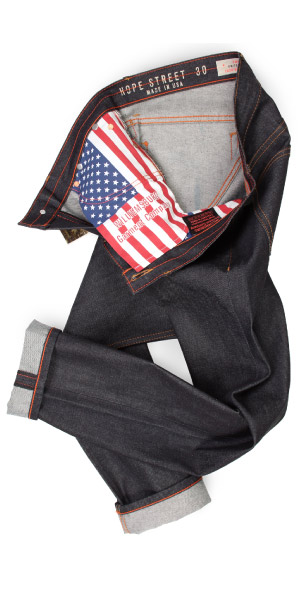
During the downturn in the economy, a small percentage of Americans started paying attention to where the products they bought were made. This small change in the buying habits of some has helped contribute to slowing the tremendous growth in China and other countries while the U.S. economy rebounded. During my last trips to China, I noticed business was no longer booming and many construction projects were stalled.
Many factors go into changes in economies and I know this to be true: How you spend your money makes a difference along the chain of who you decide to spend it with as much as it affects you. I can go on, but I’m not trying to be a political pundit or running for office so I’ll leave it at that.
You might be interested in
Denim nerds, beware. Union Special 43200G myths are dispelled and I explain how the roping effect is really achieved.
A review of Tsingtao beer, brewed by the sixth largest brewer in the world, in Qingdao, China, mixing Chinese and
America’s leading supplier of high-quality denim fabrics since 1891, closing its 112-year-old White Oak Plant in Greensboro, North Carolina.
Our company has grown by staying small and maximizing its efforts. Knowing who you are, what you do, and who
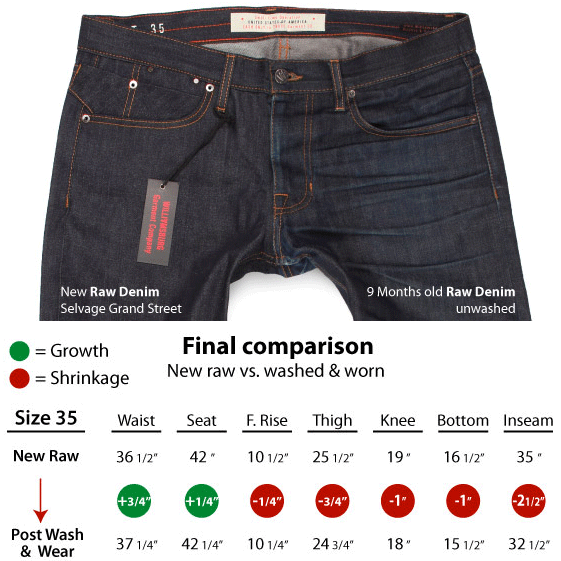
I recorded the changes in my selvedge Grand Street jeans as they went through the process of wearing and washing. I did this because lots of our customers often ask the same set of questions when it comes to raw denim jeans.
- How much do raw denim jeans shrink?
- How much do raw denim jeans stretch or grow?
- Should I buy a size larger and then soak the jeans?
- Do I buy a size down, and then wear them until the jeans stretch & grow?
Above you’ll find on the left an image of a new pair of raw jeans combined with jeans on the right worn 9 months without a wash. The best thing about aging your jeans as opposed to purchasing a jean pre-washed, is you get authentic wear effects unique to your own body and wearing experience.
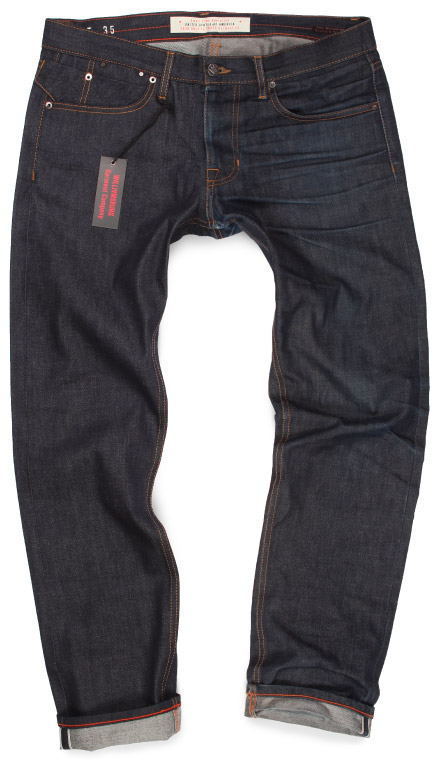
Below, you will find the whole process detailing how I ended up at the measurements above. Again, the new pair of raw jeans on the left combined with jeans after wearing 9 months without a wash, merged on the right.
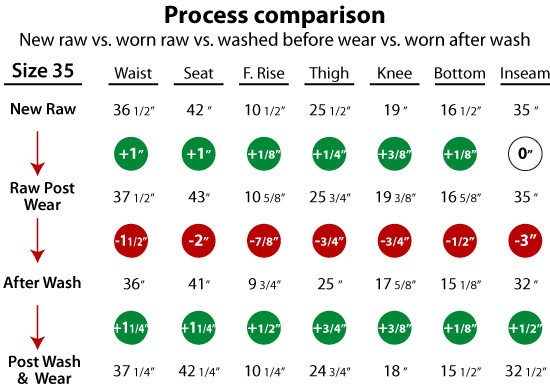
For a guy like me, with a large seat and athletic legs, the outcome was growth in the highly stressed areas of the seat and waist from bending, even after washing. There is also a lot of friction in the crotch area, which causes fraying at the seams and holes to develop in the denim, which is typical for guys that wear their jeans lower on the hips. Those who wear jeans higher near the waistline may not get as much friction and wear in the crotch area.
On another note, the white in the base color becomes slightly dark from oils absorbed from the skin. After I did the first wash of the jeans, the blue was still pretty dark, but the white yarns were brighter. You can see this in the animated images from my earlier post or in the slide show on Heddles.com.
You might be interested in
TCB Jeans crafts history into every stitch, reviving iconic denim like the 1966 Levi’s 501 and the 1955 Levi’s 701
Nick English from Stridewise visited our studio at 67 West Street to expertly tailor his jeans at the waist. Watch
How to measure the inseam of twisted-leg jeans is made clear in our video lesson. Learn how to handle this
Is it called selvedge or selvage and what is it? We explain.
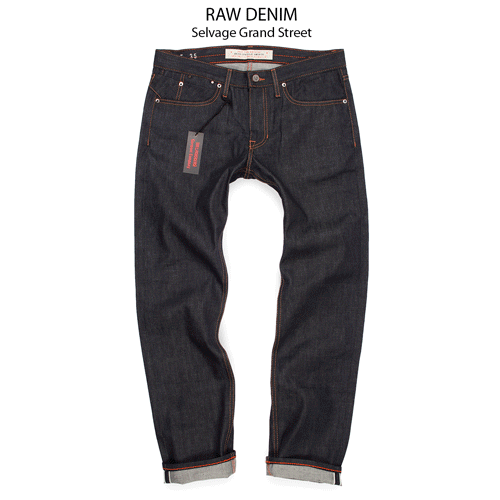
Back in the summer of 2015, I wore my new selvedge raw denim Grand Street jeans working inside our warehouse about 4 days per week to beat them up and to create and record these time-lapsed photos to show how raw jeans fade over time. After 9 months of wearing the jeans without washing, I gave them a machine wash to quickly get rid of the loose dye, oils, and dirt. I then wore them another month before giving them another machine wash for more abrasion, speed fading, and to create streaks. At this point, I lost another shade and the jeans were a perfect medium blue with some fraying.
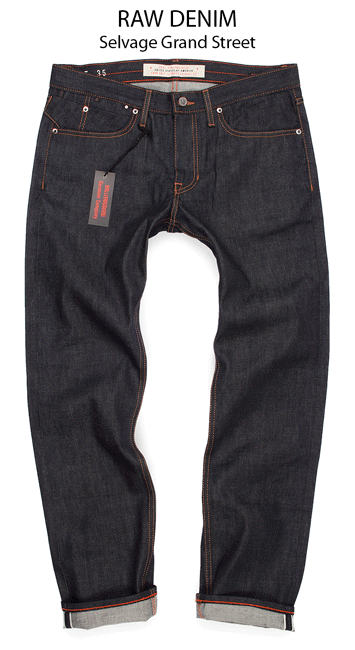
You might be interested in
TCB Jeans crafts history into every stitch, reviving iconic denim like the 1966 Levi’s 501 and the 1955 Levi’s 701
Nick English from Stridewise visited our studio at 67 West Street to expertly tailor his jeans at the waist. Watch
In a sea of seasonal brews, Master of Pumpkins Ale by Tröegs Independent Brewing rises to the top. Our review
How to measure the inseam of twisted-leg jeans is made clear in our video lesson. Learn how to handle this





